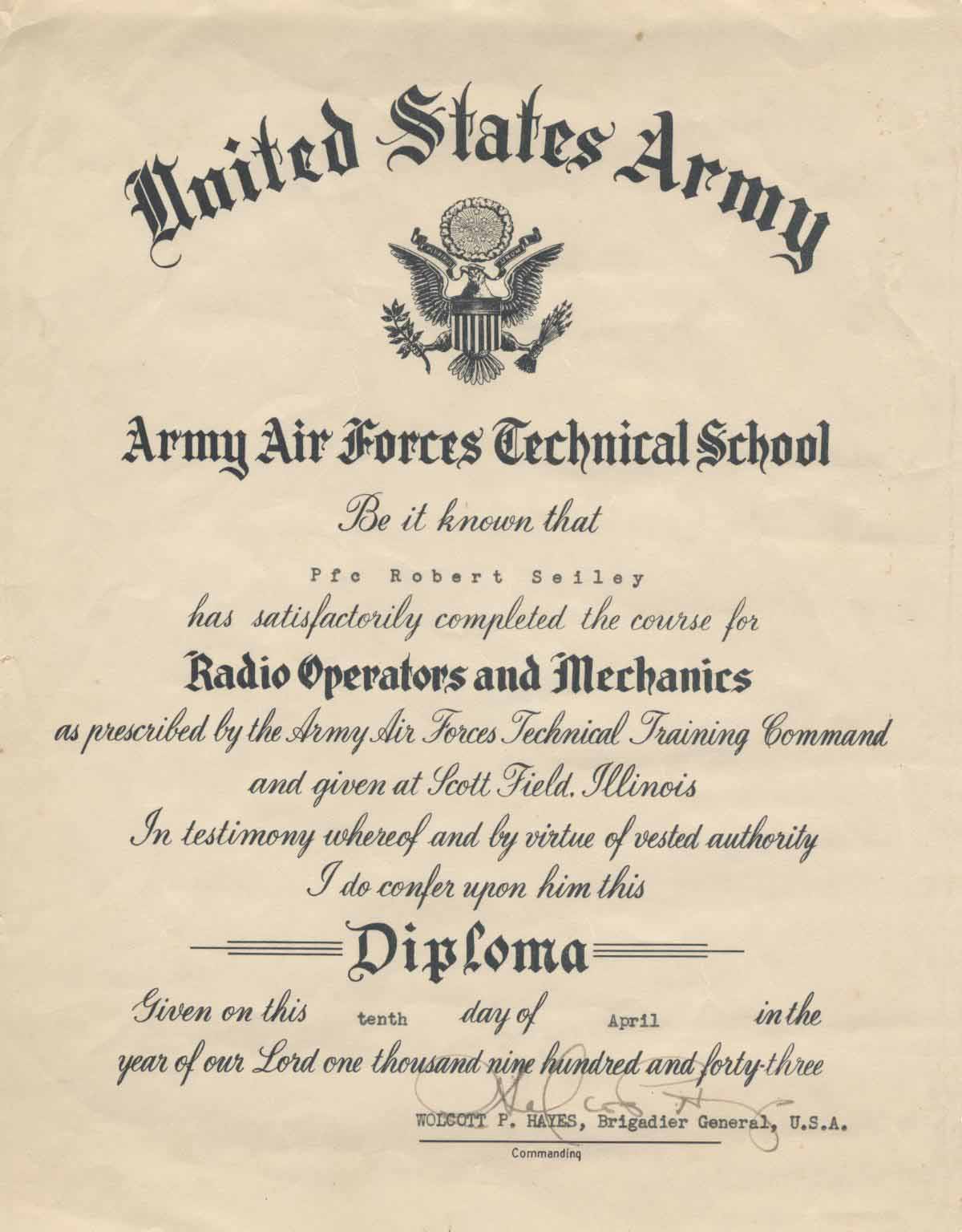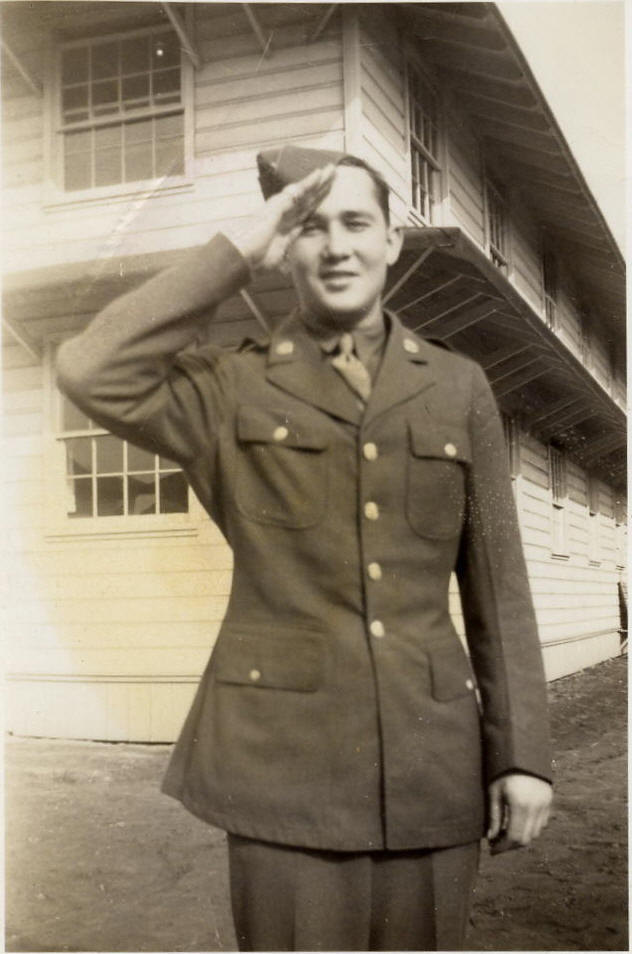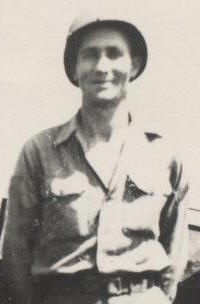|
HOME
Contact Me
Sources
& Links
Service in the States October ’42 - June ‘44
 Scott
Field, Ill Scott
Field, Ill
 Seymour-Johnson Field,
Seymour-Johnson Field,
N.C.
 Yale
University, Yale
University,
New Haven CT.
ETO Jan'45 - May '45: 320th Bomber Group
 England England
 France: First
Tactical France: First
Tactical
Air Force
 443rd
Bomber 443rd
Bomber
Squadron
 Air Medal,
DUC Air Medal,
DUC
 Photographs Photographs
ETO Mahy '45 - Home: 397th
Bomber Group
 598th Bomber
Squadron 598th Bomber
Squadron
 LT David L.
Lobeck LT David L.
Lobeck
 The crash of The crash of
B26G 44-67868
"Kwitcher Bitchin'"
Family in Service
(Under
Construction)
 Curtis Seiley
Curtis Seiley
 Carl
Seiley Carl
Seiley
 Butch
Seiley Butch
Seiley
 John
Seiley John
Seiley
 A. M.
Seiley A. M.
Seiley
 Mark
Seiley Mark
Seiley

Dad’s AAF
Technician Badge with “Radio Operator” and “Radio Mechanic” qualification
bars. This and the ACTS Trainer badge (below) are worn by Dad and Bill
Harmon in the photo to the right.
à


Dad at
Belleville, Ill.
September 8, 1943. Saint Louis Post headline reads, “Italy Surrenders”.
Bottom of photo reads “The beginning of the end.”
|
Scott Field, Illinois
Dad entered
active service on 29 October, 1942 at Shreveport, Louisiana.
Letters from his father, A. M. Seiley, indicate he was stationed at Scott
Field, Ill, as part of the 368th Tech. School Squadron as early as
December 8th of ’42, with the rank of Pvt. Presumably the time
between 29 October and December was occupied by basic training (at
Shreveport?).
Scott Field
became known as the
“Communications University of the Army Air Forces”, producing some 77,000+
graduates by the end of the war who served on thousands of AAF aircraft,
including B-17s, B-29s, and of course B-26s. Dad completed training
in Radio Operations and Mechanics, receiving the d iploma
you see at right from the Army Air Forces Technical School, Scott Field,
on 10 April 1943, signed by Wolcott P. Hayes, Brigadier General,
Commanding. iploma
you see at right from the Army Air Forces Technical School, Scott Field,
on 10 April 1943, signed by Wolcott P. Hayes, Brigadier General,
Commanding.
What additional
training Dad continued with at Scott Field after 10 April “graduation” is
unclear, but what is clear is he appeared to be stationed there through
September 1943 based on the photographs below which have the noted dates
and locations scribed on the back by my father. The ACTS Instructor
badge (see image below left) seems to indicate Dad taught as well.
(Photo at left: “January 18, 1943, Scott Field, Ill.”)
 
Above Left:
“Stoffer (left), Bill (right), and I (center), August, 1943, Scott Field”
Above Right: “Dick (left) and I (right) September, 1943, Scott Field,
Ill.”

“Bill Harmon (right) and I, August, 1943”
Seymour-Johnson Field, North Carolina
By the end of December
1943, letters to my father from his brother Curtis (serving in Italy with
the 976th Field Artillery Battalion) are addressed “A/C Robert E. Seiley,
SQD. ‘C’ – Sec. 45 A.C.P.T.S, Seymour-Johnson Field, N.C.” Unless I am
mistaken, “A/C” stood for “Army Cadet” and “ACPTS” stood for “Army Cadet
Pre-Training School”.
According to the Seymour Johnson
site: “Seymour Johnson Field was
activated on June 12, 1942, as Headquarters, Technical School, Army Air
Forces Technical Training Command... Seymour Johnson Field received a
third mission in September 1943: to provide basic military training for
cadets preparing to become technical officers in the Army Air Corps. The
75th Training Wing was established to conduct the program through its
Aviation Cadet Pre-Training School.” Dad however, does not end up an
officer, for whatever reason. But clearly he was there for additional
technical training.
Dad was at Seymour at least through January 1944, when Curtis references
Dad “…sweating out those exams.” According to his “Enlisted Record and
Report of Separation” (Form 55) Dad received a military qualification in
January of 1944 known as “MKM P” which I believe refers to a firearm
qualification, perhaps for a pistol. It appears then, that this
qualification was perhaps part of the cadet pre-training at
Seymour-Johnson Field.
Yale University, New Haven, Connecticut
By 10 March 1944, a
letter to Dad from Curtis is still addressed: “A/C”, but now at “SQDN. S –
Div. 27 TS – AAETTC, Yale University, New Haven, Conn.” At this point
Curtis is writing Dad from “…somewhere on the Anzio beach head.” I’m not
sure what “AAETTC” stands for, but it may be a typo for “AAFTTC” for “Army
Air Force Technical Training Command”, as Yale University was essentially
taken over in 1943-44 for training of AAFTTC service personnel.
During this period, according to
Yale Alumni Magazine, “The cadets attended classes eight hours a day,
six days a week, for periods of 6 to 20 weeks, to qualify as photographic
laboratory commanders, communications officers, airplane maintenance
engineers, and airplane armament officers… Military programs would soon
take over most of the campus, and 20,000 service men and women, including
12,000 aviation cadets, were trained in all.”
One interesting note on the Yale period. Prior to his band’s transfer to Bedford
England in June 1944, Major Glenn Miller ran the band of the Technical
Training Command at (you guess ed it) Yale University. Apparently Miller
had stacked the
unit with handpicked top musicians entering the service including Ray
McKinley and Mel Powell. ed it) Yale University. Apparently Miller
had stacked the
unit with handpicked top musicians entering the service including Ray
McKinley and Mel Powell.
Uncle Curtis’ letter to Dad dated 10 March ’44
refers to Dad’s experience at Yale (where dad appears to have been
struggling) saying, “What the hell, at least you
can say you went to Yale and while you were there you had Glenn
Miller etc. playing at your meals and dances.” Comparing Dad’s situation
to that of his own on the Anzio beach head, Curtis (photo inset at right)
comments “So I’ll be able to say that I visited a famous Italian summer
resort. The music there was furnished by some jerk named Jerry.
His is strictly a novelty style – especially his drums.”
[ Home ] [ Contact me ] [ Sources & Links ] [ October '42 - June '44 ] [ June '44 - December '44 ] [ January '45 - May '45 ] [ June '45 - Home ] [ 2003 320th Association Reunion ]
Copyright© 2003-4 Joseph
M. Seiley. All rights reserved
|